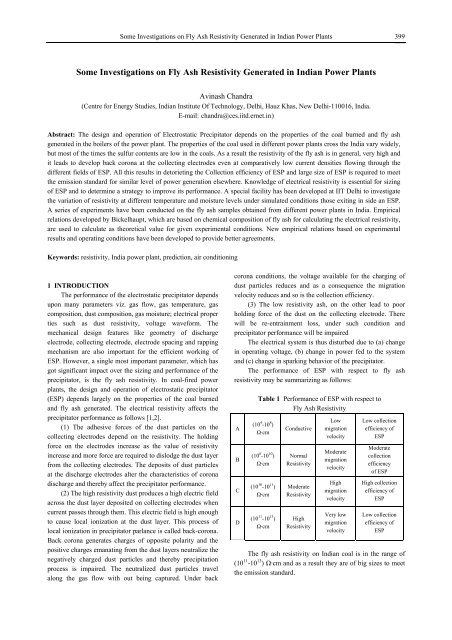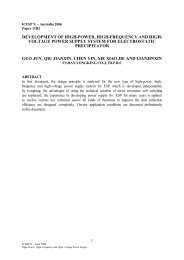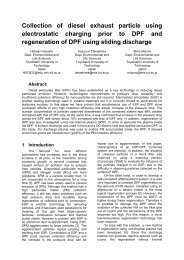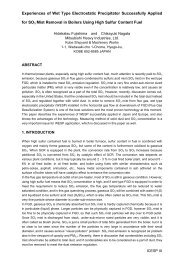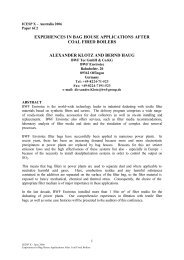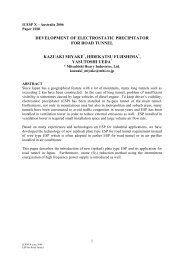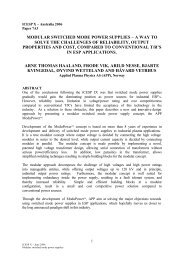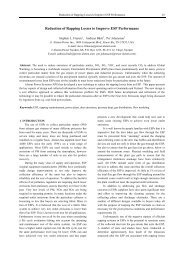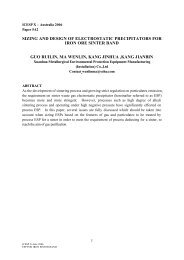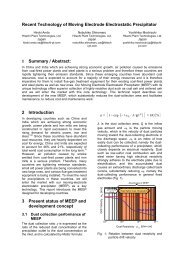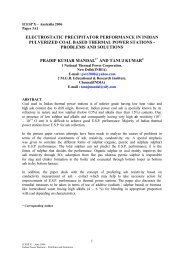Some Investigations on Fly Ash Resistivity Generated in ... - isesp
Some Investigations on Fly Ash Resistivity Generated in ... - isesp
Some Investigations on Fly Ash Resistivity Generated in ... - isesp
- No tags were found...
Create successful ePaper yourself
Turn your PDF publications into a flip-book with our unique Google optimized e-Paper software.
<str<strong>on</strong>g>Some</str<strong>on</strong>g> <str<strong>on</strong>g>Investigati<strong>on</strong>s</str<strong>on</strong>g> <strong>on</strong> <strong>Fly</strong> <strong>Ash</strong> <strong>Resistivity</strong> <strong>Generated</strong> <strong>in</strong> Indian Power Plants 399<str<strong>on</strong>g>Some</str<strong>on</strong>g> <str<strong>on</strong>g>Investigati<strong>on</strong>s</str<strong>on</strong>g> <strong>on</strong> <strong>Fly</strong> <strong>Ash</strong> <strong>Resistivity</strong> <strong>Generated</strong> <strong>in</strong> Indian Power PlantsAv<strong>in</strong>ash Chandra(Centre for Energy Studies, Indian Institute Of Technology, Delhi, Hauz Khas, New Delhi-110016, India.E-mail: Hchandra@ces.iitd.ernet.<strong>in</strong>H)Abstract: The design and operati<strong>on</strong> of Electrostatic Precipitator depends <strong>on</strong> the properties of the coal burned and fly ashgenerated <strong>in</strong> the boilers of the power plant. The properties of the coal used <strong>in</strong> different power plants cross the India vary widely,but most of the times the sulfur c<strong>on</strong>tents are low <strong>in</strong> the coals. As a result the resistivity of the fly ash is <strong>in</strong> general, very high andit leads to develop back cor<strong>on</strong>a at the collect<strong>in</strong>g electrodes even at comparatively low current densities flow<strong>in</strong>g through thedifferent fields of ESP. All this results <strong>in</strong> detoriet<strong>in</strong>g the Collecti<strong>on</strong> efficiency of ESP and large size of ESP is required to meetthe emissi<strong>on</strong> standard for similar level of power generati<strong>on</strong> elsewhere. Knowledge of electrical resistivity is essential for siz<strong>in</strong>gof ESP and to determ<strong>in</strong>e a strategy to improve its performance. A special facility has been developed at IIT Delhi to <strong>in</strong>vestigatethe variati<strong>on</strong> of resistivity at different temperature and moisture levels under simulated c<strong>on</strong>diti<strong>on</strong>s those exit<strong>in</strong>g <strong>in</strong> side an ESP.A series of experiments have been c<strong>on</strong>ducted <strong>on</strong> the fly ash samples obta<strong>in</strong>ed from different power plants <strong>in</strong> India. Empiricalrelati<strong>on</strong>s developed by Bickelhaupt, which are based <strong>on</strong> chemical compositi<strong>on</strong> of fly ash for calculat<strong>in</strong>g the electrical resistivity,are used to calculate as theoretical value for given experimental c<strong>on</strong>diti<strong>on</strong>s. New empirical relati<strong>on</strong>s based <strong>on</strong> experimentalresults and operat<strong>in</strong>g c<strong>on</strong>diti<strong>on</strong>s have been developed to provide better agreements.Keywords: resistivity, India power plant, predicti<strong>on</strong>, air c<strong>on</strong>diti<strong>on</strong><strong>in</strong>g1 INTRODUCTIONThe performance of the electrostatic precipitator dependsup<strong>on</strong> many parameters viz. gas flow, gas temperature, gascompositi<strong>on</strong>, dust compositi<strong>on</strong>, gas moisture; electrical properties such as dust resistivity, voltage waveform. Themechanical design features like geometry of dischargeelectrode, collect<strong>in</strong>g electrode, electrode spac<strong>in</strong>g and rapp<strong>in</strong>gmechanism are also important for the efficient work<strong>in</strong>g ofESP. However, a s<strong>in</strong>gle most important parameter, which hasgot significant impact over the siz<strong>in</strong>g and performance of theprecipitator, is the fly ash resistivity. In coal-fired powerplants, the design and operati<strong>on</strong> of electrostatic precipitator(ESP) depends largely <strong>on</strong> the properties of the coal burnedand fly ash generated. The electrical resistivity affects theprecipitator performance as follows [1,2].(1) The adhesive forces of the dust particles <strong>on</strong> thecollect<strong>in</strong>g electrodes depend <strong>on</strong> the resistivity. The hold<strong>in</strong>gforce <strong>on</strong> the electrodes <strong>in</strong>crease as the value of resistivity<strong>in</strong>crease and more force are required to dislodge the dust layerfrom the collect<strong>in</strong>g electrodes. The deposits of dust particlesat the discharge electrodes alter the characteristics of cor<strong>on</strong>adischarge and thereby affect the precipitator performance.(2) The high resistivity dust produces a high electric fieldacross the dust layer deposited <strong>on</strong> collect<strong>in</strong>g electrodes whencurrent passes through them. This electric field is high enoughto cause local i<strong>on</strong>izati<strong>on</strong> at the dust layer. This process oflocal i<strong>on</strong>izati<strong>on</strong> <strong>in</strong> precipitator parlance is called back-cor<strong>on</strong>a.Back cor<strong>on</strong>a generates charges of opposite polarity and thepositive charges emanat<strong>in</strong>g from the dust layers neutralize thenegatively charged dust particles and thereby precipitati<strong>on</strong>process is impaired. The neutralized dust particles travelal<strong>on</strong>g the gas flow with out be<strong>in</strong>g captured. Under backcor<strong>on</strong>a c<strong>on</strong>diti<strong>on</strong>s, the voltage available for the charg<strong>in</strong>g ofdust particles reduces and as a c<strong>on</strong>sequence the migrati<strong>on</strong>velocity reduces and so is the collecti<strong>on</strong> efficiency.(3) The low resistivity ash, <strong>on</strong> the other lead to poorhold<strong>in</strong>g force of the dust <strong>on</strong> the collect<strong>in</strong>g electrode. Therewill be re-entra<strong>in</strong>ment loss, under such c<strong>on</strong>diti<strong>on</strong> andprecipitator performance will be impairedThe electrical system is thus disturbed due to (a) change<strong>in</strong> operat<strong>in</strong>g voltage, (b) change <strong>in</strong> power fed to the systemand (c) change <strong>in</strong> spark<strong>in</strong>g behavior of the precipitator.The performance of ESP with respect to fly ashresistivity may be summariz<strong>in</strong>g as follows:ABCDTable 1 Performance of ESP with respect to<strong>Fly</strong> <strong>Ash</strong> <strong>Resistivity</strong>(10 4 -10 8 )Ω·cm(10 8 -10 10 )Ω·cm(10 10 -10 11 )Ω·cm(10 11 -10 13 )Ω·cmC<strong>on</strong>ductiveNormal<strong>Resistivity</strong>Moderate<strong>Resistivity</strong>High<strong>Resistivity</strong>Lowmigrati<strong>on</strong>velocityModeratemigrati<strong>on</strong>velocityHighmigrati<strong>on</strong>velocityVery lowmigrati<strong>on</strong>velocityLow collecti<strong>on</strong>efficiency ofESPModeratecollecti<strong>on</strong>efficiencyof ESPHigh collecti<strong>on</strong>efficiency ofESPLow collecti<strong>on</strong>efficiency ofESPThe fly ash resistivity <strong>on</strong> Indian coal is <strong>in</strong> the range of(10 11 -10 13 ) Ω·cm and as a result they are of big sizes to meetthe emissi<strong>on</strong> standard.
40011th Internati<strong>on</strong>al C<strong>on</strong>ference <strong>on</strong> Electrostatic Precipitati<strong>on</strong>Chemical Compositi<strong>on</strong> and Electrical <strong>Resistivity</strong>The electrical properties of fly ash depend <strong>on</strong> thechemical compositi<strong>on</strong> of coal ash feed and combusti<strong>on</strong>c<strong>on</strong>diti<strong>on</strong>s prevail<strong>in</strong>g <strong>in</strong> the boiler of the power plant. It is,therefore important to understand the relati<strong>on</strong> between thechemical compositi<strong>on</strong> of fly ash com<strong>in</strong>g out from the boilerand its electrical resistivity besides its compositi<strong>on</strong> itstemperature and moisture c<strong>on</strong>tents are also important. Theaverage characteristic of Indian coal is given <strong>in</strong> Table 2 [3]. Inmany of the power plants <strong>in</strong> India, the ash c<strong>on</strong>tent of coal isas high as 45%. Thus compared with the U.S. and Europeancoals, Indian coals generate about 6 t0 7 times more ash forcollecti<strong>on</strong> by the ESPs for similar electricity generati<strong>on</strong>.Moreover, the properties of fly ash generated <strong>in</strong> India are alsosignificantly different. Because of the low sulfur c<strong>on</strong>tent (lessthan 0.6%), and chlor<strong>in</strong>e c<strong>on</strong>tent is less than 0.1%, [4] theresistivity of fly ash is 100 to 1000 times higher than thatgenerated, say, <strong>in</strong> U.S. As a result, the ESPs <strong>in</strong> India, despitebe<strong>in</strong>g much larger, have lower collecti<strong>on</strong> efficiencies, than theESPs <strong>in</strong> U.S. Thus knowledge of fly ash resistivity is essentialfor the design improvements of ESPs. The electricalresistivity of fly ash str<strong>on</strong>gly depends <strong>on</strong> the chemicalcompositi<strong>on</strong> of the fly ash. Major c<strong>on</strong>stitute of the fly ash aresilica (SiO 2 ), alum<strong>in</strong>a (Al 2 O 3 ) and ir<strong>on</strong> oxides (Fe 2 O 3 ), Table3 <strong>in</strong>dicates the typical fly ash chemical compositi<strong>on</strong>s data forsome of the Indian thermal power stati<strong>on</strong>s.Coal M<strong>in</strong>esCharacteristicsProximateAnalysis (%)MoistureVolatile matterFixed Carb<strong>on</strong><strong>Ash</strong>SulphurHHV(kJ/kg)Ultimate (<strong>Ash</strong>)Analysis (%)SiO 2Al 2 O 3Fe 2 O 3TiO 2P2O5CaoMgOSO 3Na 2 O 3K 2 OMn OTable 2 Average characteristics of Indian coalS<strong>in</strong>gareni Kushm–anda S<strong>in</strong>grauli Jharia Neyveli9.623.332.934.00.3634133.359.3522.048.05––5.572.26––––10.023.025.040.50.285590.061.327.425.281.700.541.420.970.231.07–0.05512.020.127.940.00.313641.660.7325.76.41.760.71.20.930.260.261.73–13.017.5128.2236.080.413300.057.6426.3910.191.430.821.780.600.590.20––42.5224.519.57.50.632850.065.213.273.6––11.25.01.370.320.04–Totalaveragevalue17.4221.6826.7031.610.393902.9860.8422.966.701.630.684.231.950.610.460.880.05S. No. Power stati<strong>on</strong>s1.2.3.4.5.6.7.8.9.10.11.BadarpurDadriRihandUnchaharKorbaV<strong>in</strong>dhyanchalRamagundamVijayawadaNeyveliKahalgoanFarakkaTable 3 Chemical compositi<strong>on</strong> of Indian fly ash<strong>Fly</strong> <strong>Ash</strong> Compounds (weight %)SiO 2 Al 2 O 3 TiO 2 Fe 2 O 3 Mn O MgO Cao K 2 O Na 2 O 3 LOI57.3652.7459.7559.6062.0962.8960.8361.6338.0360.3560.3031.7837.8034.130.6031.3027.0826.6330.9243.3830.1230.901.650.900.51.501.821.101.131.721.821.811.304.623.416.14.203.336.124.193.334.055.625.020.21b.d.0.40.10b.d.b.d.0.08b.d.0.12b.d.b.d.0.230.240.350.400.010.100.800.050.020.400.600.621.000.20.900.030.803.031.117.670.800.900.590.660.450.700.040.270.900.610.050.560.500.230.140.30.200.090.100.400.130.430.120.152.663.010.45–1.211.501.810.403.400.200.30
<str<strong>on</strong>g>Some</str<strong>on</strong>g> <str<strong>on</strong>g>Investigati<strong>on</strong>s</str<strong>on</strong>g> <strong>on</strong> <strong>Fly</strong> <strong>Ash</strong> <strong>Resistivity</strong> <strong>Generated</strong> <strong>in</strong> Indian Power Plants 401Table 4 Effect of fly ash chemistry <strong>on</strong> resistivityChemical c<strong>on</strong>stituent Property Effect <strong>on</strong> <strong>Resistivity</strong>Silica (SiO 2 )Alum<strong>in</strong>a (Al 2 O 3 )Calcium Oxide (CaO)Ir<strong>on</strong> Oxide (Fe 2 O 3 )Sodium Oxide (Na 2 O)Phosphorous pentaoxide (P 2 O 5 )Pottasium Oxide (K 2 O)Sulphur Trioxide (SO 3 )Lithium Oxide (Li 2 O 3 )Titania (TiO 2 )Magnesia(MgO)InsulatorInsulatorSO 3 absorberIncreases alkali i<strong>on</strong> solubility and mobilityI<strong>on</strong> C<strong>on</strong>tributorI<strong>on</strong> C<strong>on</strong>tributorI<strong>on</strong> C<strong>on</strong>tributorI<strong>on</strong> C<strong>on</strong>tributorI<strong>on</strong> C<strong>on</strong>tributor––––IncreaseIncreaseIncreaseDecreaseDecreaseDecreaseDecreaseDecreaseDecrease––––In view of the importance of the resistivity of the fly ashcompositi<strong>on</strong> (Table 4) as a primary factor of the performanceof a precipitator, it become necessary the knowledge of the flyash chemistry effect <strong>on</strong> resistivity (as shown <strong>in</strong> Table 4). Itmay be noted that silica, alum<strong>in</strong>a, and calcium oxide rangebetween 85 to 90% lead<strong>in</strong>g to higher resistivity. [6] Theelectrical resistivity depends <strong>on</strong> its chemical compositi<strong>on</strong>,temperature, and moisture. A number of empirical relati<strong>on</strong>shave been developed to predict the electrical resistivity of flyash as a functi<strong>on</strong> of various parameters menti<strong>on</strong>ed earlier [5,6]. A set of correlati<strong>on</strong>s for predict<strong>in</strong>g fly ash resistivity based<strong>on</strong> the compositi<strong>on</strong> and the coal analysis have developed byBickelhaupt [7,8] and are widely used <strong>in</strong> USA, primarily forthose fly ashes which are based <strong>on</strong> western coals. SouthernResearch Institute Birm<strong>in</strong>gham USA is also us<strong>in</strong>g similarrelati<strong>on</strong>s [9] for evaluat<strong>in</strong>g the resistivity. In India, however,there are varieties of coal used <strong>in</strong> different power plantsacross the country. They differ significantly from those used<strong>in</strong> USA. The compositi<strong>on</strong> of fly ash is too different fromthose generated <strong>in</strong> power plants <strong>in</strong> USA. The objectives of thepresent studies are: (a) to measure resistivity of representativefly ash samples from different Indian power plants andcompare the experimental results with those obta<strong>in</strong>ed fromBickelhaupt relati<strong>on</strong>s. (b) To develop mathematic model topredict the fly ash resistivity for Indian coals, <strong>in</strong> case there issignificant departure from Bickelhaupt relati<strong>on</strong>s. (c) To studythe effect of NH 3 dos<strong>in</strong>g and sodium c<strong>on</strong>diti<strong>on</strong><strong>in</strong>g of ash <strong>on</strong>the resistivity of fly ash. The samples have been obta<strong>in</strong>edfrom the Indian power plants, wherever such experimentshave been performed to improve the collecti<strong>on</strong> efficiency ofESP.2 EXPERIMENTAL ARRANGEMENT AND PROCE-DUREAn experimental test arrangement was set up per IEEEstandard criteria and guidel<strong>in</strong>es [10] for the fly ash resistivitymeasurements as shown <strong>in</strong> Fig. 1. The current across the flyash layer under test is limited to 2×10 -5 amp/cm 2 to avoid theohmic heat<strong>in</strong>g of the fly ash sample. The test apparatus<strong>in</strong>cludes four electric resistivity test cells enclosed <strong>in</strong> such amanner that the test cells are housed <strong>in</strong> a thermally c<strong>on</strong>trolledchamber so that resistivity can be determ<strong>in</strong>ed at temperaturerange of 90 ℃-455 ℃. A dc high voltage power supply wasused to impress the required magnitude of electric fieldstrength. The envir<strong>on</strong>ment was ma<strong>in</strong>ta<strong>in</strong>ed as per thestandard. The envir<strong>on</strong>mental water c<strong>on</strong>centrati<strong>on</strong> was<strong>in</strong>troduced by bubbl<strong>in</strong>g a porti<strong>on</strong> of dry gas through distilledwater ma<strong>in</strong>ta<strong>in</strong>ed at a selected temperature <strong>in</strong> athermostatically c<strong>on</strong>trolled water bath. It was 9% by volumeat the specified temperature <strong>in</strong> the present study. The oven iscapable of operat<strong>in</strong>g <strong>in</strong> the desired temperature range, with<strong>in</strong>0.01 ℃ accuracy. The resistivity test cell has parallel platec<strong>on</strong>struc-ti<strong>on</strong> made from SS 304 steel. The resistivity cellcurrent was measured us<strong>in</strong>g a sensitive electrometer capableof read<strong>in</strong>g current <strong>in</strong> the range o 10 -3 to 10 -11 amp. with anaccuracy of ± 2% of the full-scale read<strong>in</strong>g. <strong>Fly</strong> ash sampleswere prepared <strong>in</strong> accordance with the IEEE standard andplaced <strong>in</strong> the test cell <strong>in</strong> a grounded envir<strong>on</strong>mental chamber.The upper electrode is gently placed <strong>on</strong> the top of ash with adef<strong>in</strong>ed pressure. The oven is started and <strong>on</strong>ce the desiredtemperatures are reached, the read<strong>in</strong>gs are taken for thetemperature, voltage and current us<strong>in</strong>g the <strong>in</strong>strumentati<strong>on</strong>provided <strong>in</strong> the test facility. The fly ash resistivity, ρ iscalculated from standard relati<strong>on</strong>:⎛V⎞⎛ A⎞ρ = ⎜ ⎟⎜ ⎟⎝ I ⎠⎝ l ⎠where, V and I are the voltage and current across the fly ashsample, l and A represent the thickness and area of crosssecti<strong>on</strong>of sample of fly ash cell. The resistivity is calculatedfor more than 250 different fly ash samples from Indian coalfired thermal power plants for the temperature range of 90 ℃to 460 ℃. However, 20 representative samples have beenselected whose chemical compositi<strong>on</strong> is known, for thedevelopment of model for ash resistivity.3 EMPIRICAL RELATIONS FOR PREDICTION OFFLY ASH RESISTIVITYBased <strong>on</strong> the chemical compositi<strong>on</strong>s of representative flyash samples, shown <strong>in</strong> Table 5, the electrical resistivity has
40211th Internati<strong>on</strong>al C<strong>on</strong>ference <strong>on</strong> Electrostatic Precipitati<strong>on</strong>been calculated us<strong>in</strong>g Bickelhaupt [11] correlati<strong>on</strong>s, whichare described as the follow<strong>in</strong>g secti<strong>on</strong>.Fig. 1 Schematic diagram of ash resistivity measurement setup at IIT DelhiTable 5 Chemical compositi<strong>on</strong> of the typical fly ash samples (weight percent as the oxide) used for calculat<strong>in</strong>gthe Electrical <strong>Resistivity</strong>Sample No. Na 2 O K 2 O MgO CaO Fe 2 O 3 Al 2 O 3 SiO 2 TiO 2 P 2 O 5 SO 35 0.13 1.10 0.88 1.13 5.21 31.60 55.45 1.91 0.18 0.3813 0.09 0.59 0.54 1.63 4.22 35.95 52.97 2.19 0.10 0.5529 0.06 0.64 0.26 1.43 5.08 28.24 61.33 2.01 0.07 0.2537 0.13 0.48 0.45 2.97 7.56 24.76 60.20 1.59 0.06 0.2056 0.15 1.34 0.74 2.57 6.58 31.03 51.61 2.60 0.13 0.2364 0.15 1.04 0.73 2.30 5.46 23.70 59.64 1.90 0.9 0.033.1 Bickelhaupt Relati<strong>on</strong>sBickelhaupt [11] proposed correlati<strong>on</strong>s to calculate thefly ash resistivity from the results of coal and the fly ashanalysis. The correlati<strong>on</strong> fly ash resistivity <strong>in</strong> terms of volumeresistivity, surface resistivityAnd adsorbed acid resistivity is: The volume resistivityis:ρV= exp[( −1.8916lnX −0.9696lnY+ 1.237ln Z + 3.62876) − ( 0.069078)E(1)+ ( 9980.58 )]TThe surface resistivity is:ρS= exp[27.59774 −2.233348lnX− 0.00176W− 0.069078E(2)− 0.00073895W( exp ) 2303.3 ]TThe adsorbed acid resistivity is:ρ exp[59.0677 0.854721CSO 13049.47a= −3−T− 0.069078 E](3)For Z > 3.5% or K < 1.0 %The resultant resistivity is:1 1 1= +ρvsaρvsρa(4)1 1 1where = +ρvs ρv ρs(5)3.2 Proposed Correlati<strong>on</strong> for <strong>Fly</strong> <strong>Ash</strong> <strong>Resistivity</strong> of IndianCoalThe Bickelhaupt model <strong>in</strong> equati<strong>on</strong>s is used to calculatethe resultant resistivity for three fly ash samples of Indianpower plants. Comparis<strong>on</strong> between calculated and experimentalfly ash resistivity values for these samples arepresented <strong>in</strong> Figs. 2-7. It can be observed that Bickelhauptmodel results differ appreciably from experimental values <strong>in</strong>the lower temperature range 90℃-160 ℃. It may be due to
<str<strong>on</strong>g>Some</str<strong>on</strong>g> <str<strong>on</strong>g>Investigati<strong>on</strong>s</str<strong>on</strong>g> <strong>on</strong> <strong>Fly</strong> <strong>Ash</strong> <strong>Resistivity</strong> <strong>Generated</strong> <strong>in</strong> Indian Power Plants 403significant difference <strong>in</strong> c<strong>on</strong>centrati<strong>on</strong> of elements like sulfur,lithium, sodium and moisture c<strong>on</strong>tents as well as alum<strong>in</strong>a plussilica comp<strong>on</strong>ents am<strong>on</strong>g the Indian and US coals. The sulfurc<strong>on</strong>centrati<strong>on</strong> <strong>in</strong> coal regulates the adsorbed acid resistivity.Fig. 5<strong>Resistivity</strong> (Ohm-cm)1.0E+141.0E+131.0E+121.0E+111.0E+101.0E+09Sample 051.0E+080 100 200 300 400 500Temperature (0C)Fig. 2ExperimentalBhpt modelPredicted<strong>Resistivity</strong> (Ohm-cm)1.0E+141.0E+131.0E+121.0E+111.0E+101.0E+091.0E+08Sample 56ExperimentalBhpt modelPredicted0 100 200 300 400 500Temperature (0C)Fig. 6<strong>Resistivity</strong> (Ohm-cm)1.0E+141.0E+131.0E+121.0E+111.0E+101.0E+09Sample 131.0E+080 100 200 300 400 500Temperature (0C)Fig. 3ExperimentalBhpt modelPredicted<strong>Resistivity</strong> (Ohm-cm)1.0E+141.0E+131.0E+121.0E+111.0E+101.0E+091.0E+08Sample 64ExperimentalBhpt modelPredicted0 100 200 300 400 500Temperature (0C)Fig. 7<strong>Resistivity</strong> (Ohm-cm)<strong>Resistivity</strong> (Ohm-cm)1.0E+141.0E+131.0E+121.0E+111.0E+101.0E+091.0E+081.0E+141.0E+131.0E+121.0E+111.0E+101.0E+091.0E+08Sample 290 100 200 300 400 500Temperature (0C)Fig. 4Sample 37ExperimentalBhpt modelPredictedExperimentalBhpt modelPredicted0 100 200 300 400 500Temperature (0C)Keep<strong>in</strong>g these po<strong>in</strong>ts <strong>in</strong> view, the fly ash resistivity forIndian coals was re-calculated <strong>in</strong> terms of Surface and volumec<strong>on</strong>ducti<strong>on</strong>. S<strong>in</strong>ce the c<strong>on</strong>centrati<strong>on</strong> of sulfur is very less <strong>in</strong>Indian coals, it is worthwhile to assume that very little or zeroadsorbed acid c<strong>on</strong>ductivity is present. The Negligibleadsorpti<strong>on</strong> of SO 3 c<strong>on</strong>ducti<strong>on</strong> may also be due to formati<strong>on</strong> ofglassy alum<strong>in</strong>a-silicate Surface that h<strong>in</strong>ders the adsorpti<strong>on</strong> ofSO 3 <strong>on</strong> the fly ash surface. The total c<strong>on</strong>ducti<strong>on</strong> <strong>in</strong> fly ash isthus assumed entirely due to surface and volume c<strong>on</strong>ducti<strong>on</strong>.The Bickelhaupt expressi<strong>on</strong>s for surface and volumeresistivity are therefore, modified for the Indian coals.Regressi<strong>on</strong> procedure based <strong>on</strong> the Marquardt-Levenbergalgorithm is used to f<strong>in</strong>d the coefficients of the <strong>in</strong>dependentvariables of volume and surface resistivity that give the bestfit between the proposed correlati<strong>on</strong>s and the experimentaldata. The modified correlati<strong>on</strong> for the volume and surfaceresistivity is:Correlati<strong>on</strong> for the volume resistivity:( a X b Y c Z d )ρ = exp[ − ln − ln + ln +V v v vg− ( e ) (vvE + )]TCorrelati<strong>on</strong> of the surface <strong>Resistivity</strong>:⎡gexp ln ( expS⎤ρS= as bs X cSW dsE eSW⎛ ⎞⎢− − − − ) ⎜ T ⎟⎣ ⎝ ⎠⎥⎦ (7)v(6)
40411th Internati<strong>on</strong>al C<strong>on</strong>ference <strong>on</strong> Electrostatic Precipitati<strong>on</strong>The resultant resistivity is:1 1 1= + (8)ρ ρ ρVS4 TO STUDY THE EFFECT OF NH 3 DOSING OF FLUEGASES AND SODIUM CONDITIONING OF ASH<strong>Fly</strong> ash sample were collected from power plant No.2and power plant No.3 [12]. In power plant No.2, the amm<strong>on</strong>iados<strong>in</strong>g to flue gas was varied and the <strong>in</strong>let and outlet dustload<strong>in</strong>g were measured. The fly ash samples were collectedfor no dos<strong>in</strong>g and varied amount of NH 3 . The experimentalmeasurements of electrical resistivity were made as per IEEEstandards. Similarly fly ash samples were collected frompower plants No.3 for untreated and treated with sodiumc<strong>on</strong>diti<strong>on</strong>ed coal before feed<strong>in</strong>g to boiler. Corresp<strong>on</strong>d<strong>in</strong>g datafor dust load<strong>in</strong>g was also available. In the follow<strong>in</strong>g secti<strong>on</strong>swe describe <strong>in</strong>vestigati<strong>on</strong>s related with fly ash resistivity.4.1 Investigati<strong>on</strong> <strong>on</strong> Electrical <strong>Resistivity</strong> Due to Dos<strong>in</strong>g ofAmm<strong>on</strong>ia to Flue Gases<strong>Resistivity</strong> measurement was made <strong>on</strong> the fly ashsamples between the temperatures 90 ℃-455 ℃ with 9%moisture. Measurements were made <strong>on</strong> ascend<strong>in</strong>g anddescend<strong>in</strong>g mode of temperatures for different amount ofdos<strong>in</strong>g. The follow<strong>in</strong>g observati<strong>on</strong>s are made:(1) There are significant changes <strong>in</strong> resistivity dur<strong>in</strong>gascend<strong>in</strong>g mode between no dos<strong>in</strong>g and dosed samples.(2) These changes are more pr<strong>on</strong>ounced at lowertemperatures (≤ 200 ℃); where surface c<strong>on</strong>ducti<strong>on</strong> dom<strong>in</strong>atesthrough fly ash deposited <strong>on</strong> the collect<strong>in</strong>g electrodes.(3) There is significant drop <strong>in</strong> resistivity corresp<strong>on</strong>d<strong>in</strong>gto enhanced value of migrati<strong>on</strong> velocity, collecti<strong>on</strong> efficiencyof ESP and much lower out let emissi<strong>on</strong>s.(4) The difference <strong>in</strong> resistivity between the dos<strong>in</strong>g andno dos<strong>in</strong>g c<strong>on</strong>diti<strong>on</strong>s reduce as <strong>on</strong>e goes to highertemperatures.(5) There is very little difference <strong>in</strong> resistivity betweenno dose and dosed fly ash samples <strong>in</strong> descend<strong>in</strong>g mode.One may c<strong>on</strong>clude from these observati<strong>on</strong>s thatamm<strong>on</strong>ia dos<strong>in</strong>g enhances surfaceC<strong>on</strong>ducti<strong>on</strong> (≤ 200 ℃), thereby reduc<strong>in</strong>g the resistivityby about an order of magnitude. As a result, collecti<strong>on</strong>efficiency of ESP improves and emissi<strong>on</strong> levels dropdrastically (from 166 mg/Nm 3 to 48 mg/Nm 3 ). As thetemperature raise (≥ 200 ℃), the effect of NH 3 is barelyobserved. This also expla<strong>in</strong>s why there is very little differencebetween dosed and undoes samples of fly ashes <strong>in</strong> descend<strong>in</strong>gmode.4.2 Effect of Sodium C<strong>on</strong>diti<strong>on</strong><strong>in</strong>g<strong>Fly</strong> ash samples were collected from power plant No.2.Sodium sulphate salt was added to coal mass <strong>in</strong> such amanner as to <strong>in</strong>crease the sodium oxide c<strong>on</strong>tent of fly ash by0.5% [12]. <strong>Fly</strong> ash samples from treated and untreatedc<strong>on</strong>diti<strong>on</strong>s were obta<strong>in</strong>ed and resistivity measurements weremade as per IEEE norms. Based <strong>on</strong> the experimental<strong>in</strong>vestigati<strong>on</strong>s (Fig 8), the follow<strong>in</strong>g observati<strong>on</strong>s may bemade:(1) there is significant decrease <strong>in</strong> resistivity at alltemperatures <strong>in</strong> the range 90 ℃-455 ℃.(2) This decrease of resistance corresp<strong>on</strong>ds to enhancecollecti<strong>on</strong> efficiency of ESP result<strong>in</strong>g <strong>in</strong> drastic reducti<strong>on</strong> <strong>in</strong>emissi<strong>on</strong> levels [12].(3) There is enhanced electric c<strong>on</strong>ducti<strong>on</strong> due to <strong>in</strong>creasedc<strong>on</strong>ducti<strong>on</strong> of sodium c<strong>on</strong>centrati<strong>on</strong>s both at lower (surfacec<strong>on</strong>ducti<strong>on</strong>) and higher (volume c<strong>on</strong>ducti<strong>on</strong>) temperatures. Atoperat<strong>in</strong>g temperatures of ESP 140 ℃-180 ℃ the resistivity isdecreased by an order of magnitude result<strong>in</strong>g <strong>in</strong> highermigrati<strong>on</strong> velocities.
40611th Internati<strong>on</strong>al C<strong>on</strong>ference <strong>on</strong> Electrostatic Precipitati<strong>on</strong>2. D.Visuvasam and S.Sekar, Role of fly ash Reseistivity<strong>on</strong> performance of electrostatic precipitator, BHEL’sexperience, Work shop <strong>on</strong> ESP Performance <strong>on</strong> fly ash<strong>Resistivity</strong>,IIT Delhi September 23-24, 2004.3. Chandra, A., Kumar, S. and Kumar Sanjeev.<str<strong>on</strong>g>Investigati<strong>on</strong>s</str<strong>on</strong>g> <strong>on</strong> fly ash <strong>Resistivity</strong> of varieties of Coalsused <strong>in</strong> Indian power plants, Proceed<strong>in</strong>g, 9thInternati<strong>on</strong>al C<strong>on</strong>ference <strong>on</strong> Electrostatic Precipitati<strong>on</strong>,Mpumalanga, South Africa B-05, 2004.4. Chandra, A., Sabberwal, S.P., & Mukherjee, A.K.).Performance evaluati<strong>on</strong> of an ESP unit Us<strong>in</strong>g low gradecoal. 6th Internati<strong>on</strong>al C<strong>on</strong>ference <strong>on</strong> ElectrostaticPrecipitators, Budapest, 209-214, 1996.5. White H.J., Industrial electrostatic precipitati<strong>on</strong>. Addis<strong>on</strong>Wesley, Read<strong>in</strong>g MA. 1963.6. Chandra, A., Sharma, P.K., Sanjeev, K., & Kumar, S.Effect of fogg<strong>in</strong>g, flue gas c<strong>on</strong>diti<strong>on</strong><strong>in</strong>g and sodiumdos<strong>in</strong>g of coal <strong>on</strong> fly ash <strong>Resistivity</strong>, an experimental<strong>in</strong>vestigati<strong>on</strong>. Internati<strong>on</strong>al C<strong>on</strong>ference <strong>on</strong> Energy andEnvir<strong>on</strong>ment: Strategies for Susta<strong>in</strong>able Development,New Delhi, 418-423, 2004.7. Bickelhaupt, R.E. Electrical volume c<strong>on</strong>ducti<strong>on</strong> <strong>in</strong> flyash. Journal of Air Polluti<strong>on</strong> C<strong>on</strong>trol Associati<strong>on</strong>, 24,251-255, 1974.8. Bickelhaupt, R.E. Surface <strong>Resistivity</strong> and the chemicalcompositi<strong>on</strong> of fly ash. Journal of Air Polluti<strong>on</strong> C<strong>on</strong>trolAssociati<strong>on</strong>, 25, 248-152, 1975.9. Dismukes, Edward. B. C<strong>on</strong>diti<strong>on</strong><strong>in</strong>g of fly ash withsulfur trioxide and Amm<strong>on</strong>ia. Report No.EPA-600/2-75-015, Southern research Institute, Birm<strong>in</strong>gham. AlabamaUSA. ,1975.10. IEEE Standard criteria and guidel<strong>in</strong>es for the laboratorymeasurement and report<strong>in</strong>g of fly ash <strong>Resistivity</strong>. IEEE-Standard 548, 1991.11. Bickelhaupt, R.E. A technique for predict<strong>in</strong>g fly ash<strong>Resistivity</strong>. US EPA Report No. EPA-600/7-79-204,114, 1979.12. Merchant, G.H. Jr. Evaluati<strong>on</strong> of Sodium C<strong>on</strong>diti<strong>on</strong><strong>in</strong>g,Water Fogg<strong>in</strong>g and Coal Wash<strong>in</strong>g for Envir<strong>on</strong>mentalPerformance Improvement of ESP’s at BALCO CaptivePower Plant. Research Report under USAID-India:Green house Gas Polluti<strong>on</strong> Preventi<strong>on</strong> Project, Sept.1999.


